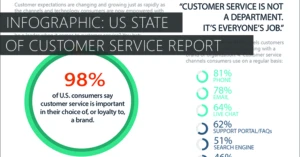
6 Things Every CEO Should Know about Customer Service
Let’s face it. Sometimes an investment or a culture change supporting customer service is a hard sell to the CEO and the C-suite. So to help make the case, here are six things every CEO should know about the importance of customer service:
1. It’s a challenging role. Customer service agents deserve a lot of credit, fielding complaints and working to solve product and service issues for hours each day, all while trying to do so with a smile or at least not feeling frustrated themselves. It’s a tough job, with average turnover rates hovering around 40% and an estimated $10,000 cost of replacing an agent.
Customer service agents serve as the voice of your brand and many times, the first (and hopefully not last) impression of it post sale. In a recent Aspect Consumer Experience Survey, 76% of consumers surveyed view customer service as the true test of how much a company values them. Make sure you’re recognizing the value of your agent in consistently proving that value.
2. If it’s considered a cost center, you’re probably doing it wrong. According to NewVoiceMedia, an estimated $41 billion is lost by U.S. companies alone each year due to poor customer service. But according to the same report, after a positive customer experience, 69% of consumers would recommend the company to others and 50% would use the business more frequently.
A Bain & Company report shows that a 5% increase in customer retention can increase profits by 25% to 95%. Another Bain & Company survey shows that customers end up spending 20% to 40% more with companies who engage and respond to social media customer service requests. According to the Peppers & Rogers Group, 81% of companies with strong capabilities and competencies for delivering customer experience excellence are outperforming their competition.
Work to deliver satisfying service that not only retains customers, but that leaves such a positive impression or is so effortless that customers will talk or tweet about it to others. Reduce call and email service costs, as well as agent training time, through self-service knowledge, and start looking at customer service as a value center.
3. It’s a brand and CEO differentiator when you’re doing it right. Brands like Zappos have laid the groundwork for customer-centricity and customer service as a brand differentiator, and continue to stand out as leaders. Affirms CEO Tony Hsieh, “Zappos is a customer service company that just happens to sell shoes.” Hsieh, Amazon’s Jeff Bezos and Virgin Group Founder Richard Branson are a sampling of some of the most well-known and successful CEOs who have risen to the top on the back of customer service and a customer-centric culture. Said Branson on the importance of customer service to where he is today:
“Look, I think that when we started Virgin Atlantic 30 years ago, we had one 747 competing with the airlines that had an average of 300 planes each. Every single one of those have gone bankrupt because they didn’t have customer service. They had might, but they didn’t have customer service, so customer service is everything in the end.”
4. It’s where most customers end their purchase or relationship if they have a bad experience. In a recent State of Multichannel Customer Service Survey commissioned by Parature, from Microsoft, 65% of 1,000 consumers surveyed said they’ve cut ties with a brand over a single poor customer service experience. It costs six times more to acquire a new customer than to retain a current one. Make sure your brand is investing in the service and support to retain customers as much as it is in the sales and marketing to acquire new ones.
5. It requires an investment in the right people and the right resources. According to the most recent Gallup State of the American Workplace report, “when organizations successfully engage both their employees and their customers they experience a 240% boost in performance-related business outcomes compared to an organization with neither engaged employees, nor engaged customers.”
Gallup notes that the moment an engaged employee connects emotionally with a customer, “it’s a source of untapped power that has profound implications for a company’s productivity and profitability.” Median differences between brands in the top quarter of employee engagement versus the bottom quarter showed a 10% difference in customer satisfaction ratings and a 22% difference in organization profitability.
But unfortunately, according to the same report, 70% of American workers say they’re either “not engaged” or are “actively disengaged” at work, and the cost is extremely high. In the Agent Apathy: The Root Cause of Poor Customer Service report, 71% of respondents recognized difficulties with their system and inefficiency of their tools as the top contributor to agent apathy and stress. Hiring more or new customer service representatives isn’t always the right answer to poor customer satisfaction rating. Empowering agents with the tools and knowledge they need to do the jobs will increase both their and your customer engagement.
6. Everyone, including the CEO, should be a customer service representative. A continuing problem with customer service today is that many view it as a job for the few, when in fact, it’s a role for all. Whether or not the word “customer” is in your job title, at the end of the day, it’s the customer who determines your job, affecting your organization’s success, reputation, revenue, product and service development, staff size and retention – the list goes on and on. If Sir Richard Branson is willing to dress up as a flight attendant and serve drinks to passengers, no one should be above doing whatever it takes to carry out a top-down commitment to customers and customer service.
CEOs, are you serving as your brand's top customer service representative?
—————
Watch the Webinar: Aligning the Customer Experience
from Brand Promise through Post-Sales Service
 In a recorded webinar, analyst Michael Krigsman discusses why companies need to become customer-focused, showing the weighting of promise, product, purchase and post-sales service when it comes to customer engagement, satisfaction and long-term brand loyalty.
In a recorded webinar, analyst Michael Krigsman discusses why companies need to become customer-focused, showing the weighting of promise, product, purchase and post-sales service when it comes to customer engagement, satisfaction and long-term brand loyalty.
Microsoft's Bill Patterson explores how the four Ps (promise, product, purchase and post-sales experience) come together and where customer service comes in. Bill and Michael provided examples of well-known brands that are laggards and leaders (those currently using productive, proactive post-sales service to amplify the brand promise, along with product and purchase success).
Quark Software Vice-President of IT and Customer Support, Mark Lawler, also joins the conversation to share how Quark is building its brand around and has doubled its Net Promoter Score through a strong investment in customer service and engagement.
Whether you’re representing a commercial brand, government agency, or growing public-facing organization, watch this free webinar at your convenience to find out where your organization currently stands in start-to-finish customer engagement and where all brands and organizations should be heading.



